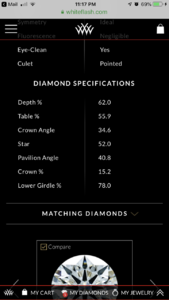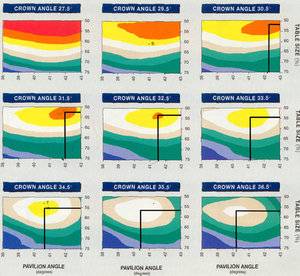chamois
Brilliant_Rock
- Joined
- Jul 15, 2008
- Messages
- 592
Are we talking cut/carat/other attributes like color, clarity?
Yes. Although happy to hear the numbers for other cut diamonds (cushion, emerald etc.). Thanks.Does the question mean only wanting one diamond? lol
CA 34.5 (34.4-34.7)
PA 40.8 (40.7-40.8
Table 55.x
Depth 61.2-61.8
LGF 77
Thin to medium
H&A
Minimal painting and digging
Perfect ASET
BGD, CBI, or ACA
G or H
SI2 or higher, must be eye clean from any distance and any angle
My wife's stone:
https://www.briangavindiamonds.com/...ls/1.070-h-vs2-round-diamond-ags-104097911013

I love my super ideal stones. However, over time I’ve discovered I really love small tables and taller crowns. Must be a result of my obsession with old cuts and fiery stones. So, for my MRBs, I definitely favor these specs:
Table: 56% or less
Crown: 35 or higher
Pavilion: 40.6
Depth: 61-62, but flexible to 62.8 when it’s paired with high CA/low PA and the spread is still evidently good.
LGF: 75-77
I think you are all at risk of narrowing your ranges way way too much.
The inverse relationship extends very broadly with many beautiful stones you would all miss out on.
I wrote this in 2000 and it is just as valid today. AGS and GIA did not believe it at the time - only Bruce Harding (1st) and my Russian friends understood.
https://www.diamond-cut.com.au/03_inverse_relationship.htm
I do not think you do understand Sledge. I invented BIC, TIC and FIC rather arbitrary boundaries..If a buyer is specifically looking for an FIC then using the inverse relationship (if I understood it correctly) would provide a BIC result; therefore, meeting the broad needs of the buying public but not necessarily their individual preference for a FIC.

Mara would say 50mmEasy - 15mm round.